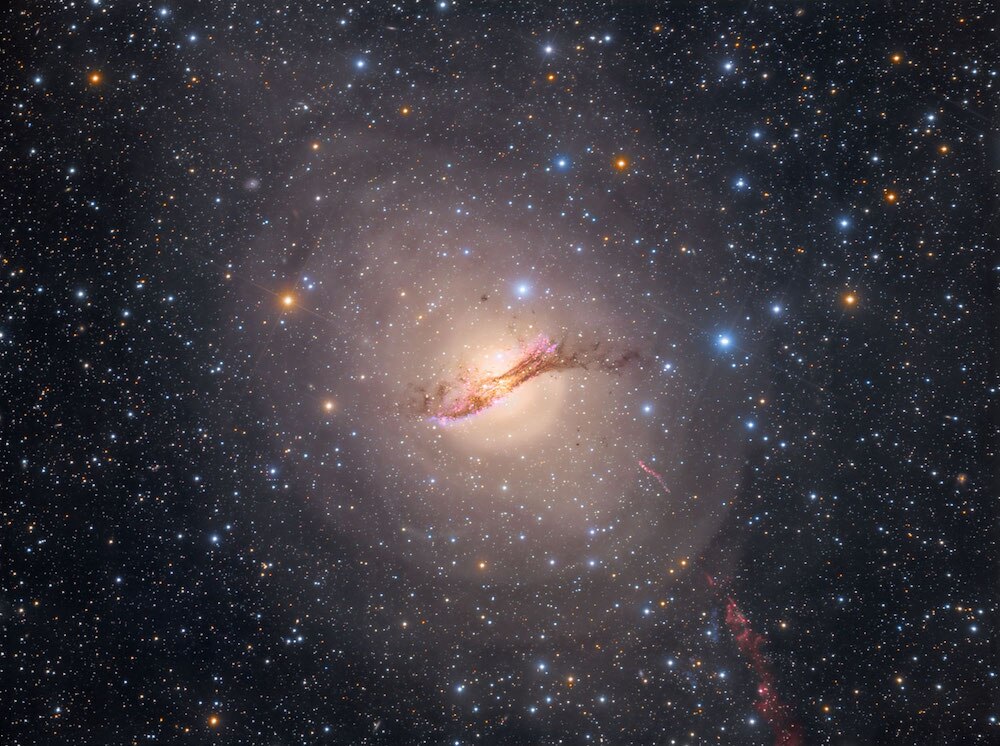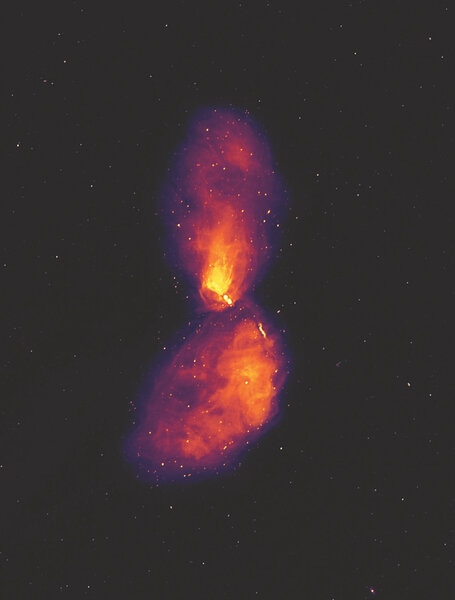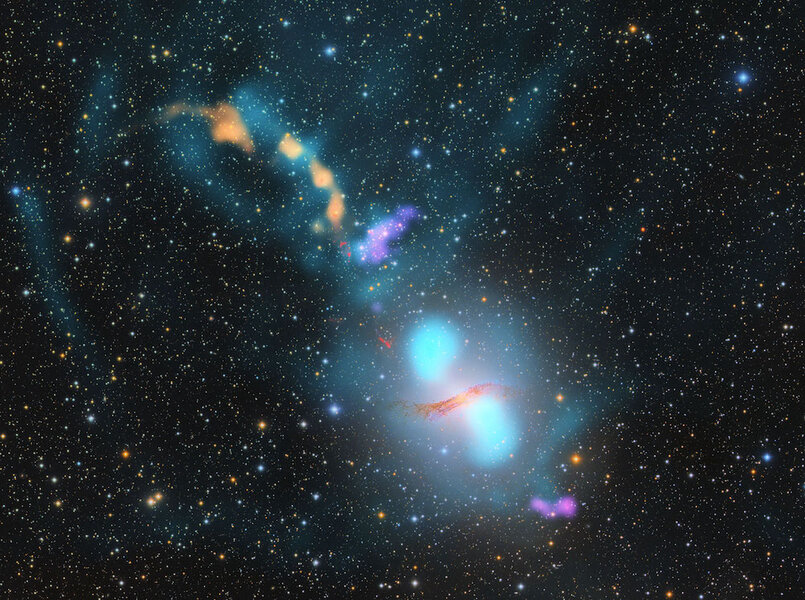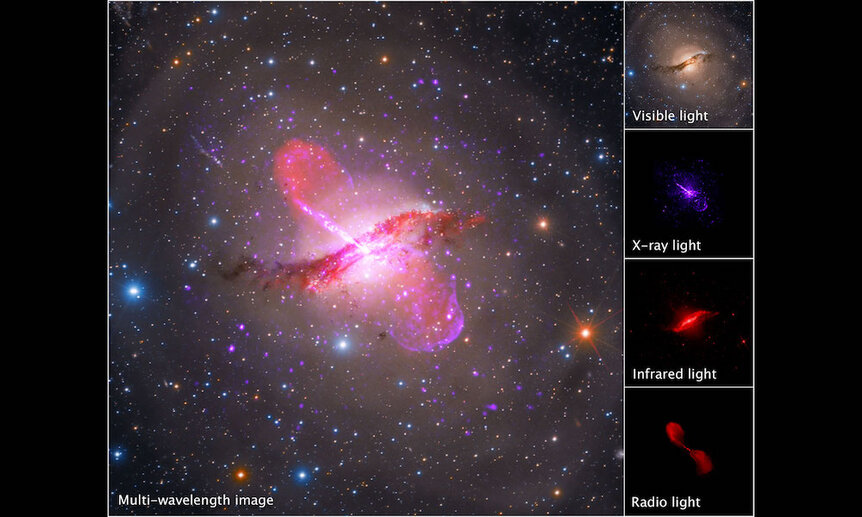Create a free profile to get unlimited access to exclusive videos, sweepstakes, and more!
Epic blast from a black hole in a nearby galaxy paints a huge swath across our sky
Centaurus A black hole creates immense structures.

Our galaxy, the Milky Way, is a pretty big one, but nonetheless fairly quiet as galaxies go.
Centaurus A, on the other hand, is only half the Milky Way's size, but the last word I'd use to describe it is quiet. Even through a small telescope it looks weird — a puffy elliptical galaxy with a broad dark swath across the middle — but when you look at it in radio waves and X-rays you see this galaxy is a screaming chaotic maelstrom, energized by a staggeringly powerful black hole in its center.
Cen A (as we in the know call it) is about 12 million light years from us, which is close, and in fact it's the fifth brightest galaxy in the sky, easily visible (from the southern hemisphere) using just binoculars. It's what we call an active galaxy: The huge supermassive black hole at its core is actively feeding, gas and dust falling into its maw. This material forms a disk around the black hole that gets infernally hot, and the twisting magnetic fields near the center, just above the black hole's event horizon, form two vortices like tornadoes. These are so strong that material is launched away from the black hole at terrifyingly high speeds, forming a pair of jets moving in opposite directions*.
Matter blasts away at very nearly the speed of light, and the amount of material shot out grinds my brain into dust: nearly three times the mass of the Sun is ejected every year. That's 6 octillion tons: 6,000,000,000,000,000,000,000,000,000 tons of material per year. Or, if you prefer, that's about the mass of the Earth firing away every 30 seconds.
Holy yikes.
Mind you, that much mass is being accelerated to tens of thousands of kilometers per second, so the energy behind it all is just simply immense. I'm glad our galaxy is quiet.
The jets eventually slow and puff out into lobes, like a gigantic Q-tip. The gas in the jets and lobes emits strongly in radio waves, but it can be difficult to observe them in detail due to their huge size. However, a team of astronomers used the relatively new Murchison Widefield Array in Australia to take a look, and what they found is mind-melting:
That image is huge: From tip to tip it covers 8°, 16 times the apparent width of the Moon in the sky. At the distance of Cen A that's equal to 1.6 million light years! And as it happens the two jets are aimed at an angle toward us, so in reality they're foreshortened from perspective, meaning they're actually physically larger.
Mind you, the galaxy itself is roughly 1/5th of a degree wide, so it's just a dot in the center of that image. The beauty of this is that the MWA observations allow details to be seen on a scale of just a few thousand light years, so that the gas dynamics can be seen.
Right away you can see the northern lobe (above) is different than the southern one (below). Cen A certainly suffered a big collision with another galaxy relatively recently; the visible light images show it looks like an elliptical galaxy but it has a broad dust lane across it. Ellipticals don't typically have dust, but if it collided with a dusty spiral that would explain its odd appearance. If the collision dumped a lot of gas to the north that would have impeded the flow of the northern jet and created all those interesting features there, leaving the southern lobe fairly intact and featureless (the bright squiggle to the right of the southern lobe is a distant background galaxy).
Looking in detail at the images, the astronomers think they've found a very interesting process going on. The gas in the jets is fiercely hot, and slams into cold gas farther out, This compresses that gas, creating denser knots and heating it up enough to generate X-rays. Just ahead of these knots are where the gas emits radio waves (we say the X-ray and radio emission is anti-coincident, so where one is bright the other is dark and vice-versa), possibly due to magnetic fields being compressed. Electrons spin around the field lines like beads on a wire, and emit radio waves.
But more than that, most of the gas in the jets, unsurprisingly, is lost to intergalactic space. But a small fraction of it cools down, forms clouds, and then these rain back down onto the galaxy itself. They eventually could make their way back to the black hole in the center, feeding it and helping to keep this process going. The details are quite complex, but the model of how that works (called the chaotic cold accretion self-regulation scenario, which I love) does seem to describe what's seen in Cen A.
It's one of the Universe's grandest ironies that supermassive black holes, with their ridiculously overmuscled gravity, can not only draw material in at fantastic rates but also power some of the most energetic phenomena in the cosmos. Not even light can escape if it gets too close to a black hole, but from farther out they power some of the most luminous events we can see.
It's rather convenient to have such a close example of an active galaxy as we do in Cen A. We can see such objects (like quasars and blazars) clear across the observable Universe, but details are lacking. With one in our back yard like this we get a chance to see it up close, in detail if needed but also take a wide view and see what it does on much larger scales. Together, we can get a more complete picture of how these phenomenal objects behave, and extrapolate that to the millions of other such galaxies spread throughout space.
*It's also possible that the jets are focused by the black hole itself, if it's spinning rapidly. It drags the fabric of spacetime around it like a whirlpool, which can also launch material away.





























